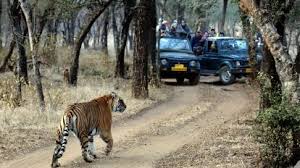Third tiger death in Ranthambore: No decision yet on panel’s advice to shift three ‘raised’ tigers

Ranthambore Tiger Reserve, famous for its majestic tigers, faces a serious problem. A third tiger has died recently, raising alarms among conservationists, forest officials, and local residents. A panel recommended relocating three ‘raised’ tigers—sub-adult tigers nurtured inside the reserve but showing problematic behavior. However, authorities have yet to make a final decision on this advice.
The Third Death Marks a Critical Point
The recent death of a sub-adult tiger marked a sad milestone. These incidents highlight the complex relationship between humans and wildlife in the reserve. Some of the tigers involved had histories of attacking people or livestock. These events increased fear among locals and forest guards.
The reserve now faces heightened challenges in managing tiger behavior and ensuring human safety. The third death intensifies debates over how best to handle these raised tigers.
Who Are the ‘Raised’ Tigers?
‘Raised’ tigers are young tigers born or raised within the reserve but showing unusual behavior. Unlike wild tigers that avoid humans, these raised ones have lost their natural fear. This usually happens due to human contact during their early life.
In some cases, these tigers grew up in enclosures or received live bait feeding. These practices can make tigers bolder around humans. They might approach villages or patrol areas where people live.
Why the Panel Recommended Relocation
A panel of wildlife experts and forest officers studied these raised tigers. They noticed that the tigers’ behavior increased conflict risks. The panel suggested relocating three of these tigers to safer, less populated forests.
Relocation aims to reduce clashes by giving tigers new habitats. It also hopes to protect local communities near Ranthambore. The idea is to help tigers survive in new places without threatening humans.
However, moving wild animals is tricky. Experts warn that relocation can cause stress for tigers. The new environment might already have resident animals, leading to fights. Also, the new area must have enough food and cover for the tigers.
Concerns About Relocation
Despite the recommendation, some experts disagree with relocating the tigers. They fear moving these raised tigers might just transfer the problem elsewhere. If tigers remain habituated to humans, conflicts might continue.
Experts worry that relocated tigers might not adapt well. Their poor hunting skills and boldness could cause trouble in new habitats. They could attack livestock or humans in the new area.
Another concern is territory disputes with resident tigers. These fights could injure or kill the newcomers. This risk raises questions about the welfare of the relocated tigers.
Managing ‘Raised’ Tigers: The Bigger Challenge
The problems with raised tigers are not unique to Ranthambore. Tigers raised in captivity or enclosures often lose hunting skills. They may depend on easy food, such as live bait provided for monitoring.
When released back into the wild, these tigers struggle to survive. They sometimes enter villages looking for food, increasing danger to people.
The forest department faces a tough job managing these tigers. They must protect both people and wildlife in a fragile balance.
Forest Department’s Current Actions
The Rajasthan Forest Department is preparing a detailed relocation plan. This plan will go to the Union Ministry of Environment, Forest and Climate Change for approval. The department includes tiger behavior studies and habitat analysis in the proposal.
Meanwhile, the department has increased patrolling near villages. They also run awareness campaigns to help locals understand tiger behavior and avoid risks.
Protecting forest guards and villagers remains a priority. These measures aim to reduce human-tiger conflict while supporting conservation.
Balancing Conservation and Safety
Ranthambore is a key site for tiger conservation. It symbolizes India’s commitment to protecting this endangered species. However, rising human-tiger conflicts call for smarter management.
Relocation alone cannot solve the problem. Conservation efforts must include habitat protection, community involvement, and conflict prevention.
Long-term solutions require patience and collaboration. Authorities need to study tiger behavior closely and involve local people.
Looking Ahead
The forest department still waits for final approval on the relocation plan. The third tiger death highlights the urgent need for action.
Experts recommend better monitoring of raised tigers. They also call for programs that help tigers develop natural behaviors.
Most importantly, conservation must respect both animal welfare and human safety. Only by balancing these can Ranthambore continue to be a safe home for tigers and people.






